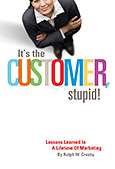Building Brand Equity
“Branding” seems to be on every business person’s lips these days, but the understanding of what constitutes branding varies from person to person. One businessman told me recently that he was proud his company had rebranded itself with a new logo and tagline.
I hastened to point out that he was talking about “brand identity,” not branding as a whole. Brand identity is an important part of building a brand image. It’s the design-driven process that helps an organization develop a name, graphic, colors and slogans. It helps differentiate the organization or its products. But it’s not the brand — only a representation of the brand.
You’ll find a truer explanation of a brand in, of all places, a June Sports Illustrated story titled: “Mud, Sweat and Beers.” The article discusses the proliferation of endurance running events, including how some entrepreneurs turned these events into money-makers. One company, Competitor Group, Inc., acquired a bunch of races and bought five racing magazines. Here’s where branding comes in.
In the article, the head of the company, David Moross, is quoted by Sports Illustrated writer Austin Murphy as explaining the magazine purchase as “a lateral platform, where someone would run in your race, love the product and become loyal to the brand.” Author Murphy goes on to explain:
“That loyalty, ideally would spur people to read the mags, sample the company’s online digital content, do some social networking, register for more events… and in the process pay more fees.”
That kind of loyalty is key to branding.
A brand itself is intangible. It exists in the mind of a customer as a pattern of feelings, associations, and ideas – the brand’s attributes that customer has come to value through experience. It represents your promises to the customer. To give the brand credibility and appeal, the promises it represents must provide evidence that the organization is unique in a way that is meaningful and beneficial to the customer.
In exchange for that value, customers give their loyalty to the organization, its products or services. It demands a special relationship, or bonding, with the customer, one that satisfies the customer’s wants or needs, practical or emotional. The value of this loyalty between customer and organization is called “brand equity.” It is the monetary or activity result of having customers who are committed to the brand, and they often are willing to pay more, give more, or advocate more for it.
Creating a good “brand identity” is great, but creating “brand equity” has much greater value.
###

 Businesses often are started by entrepreneurs with an idea, a product or service, or an expertise. Many of them fail, not because the idea or product isn’t good, but because their attention is overwhelmingly directed internally – e.g., what goes into the product – when they should focus externally, always reminding themselves:
Businesses often are started by entrepreneurs with an idea, a product or service, or an expertise. Many of them fail, not because the idea or product isn’t good, but because their attention is overwhelmingly directed internally – e.g., what goes into the product – when they should focus externally, always reminding themselves:
